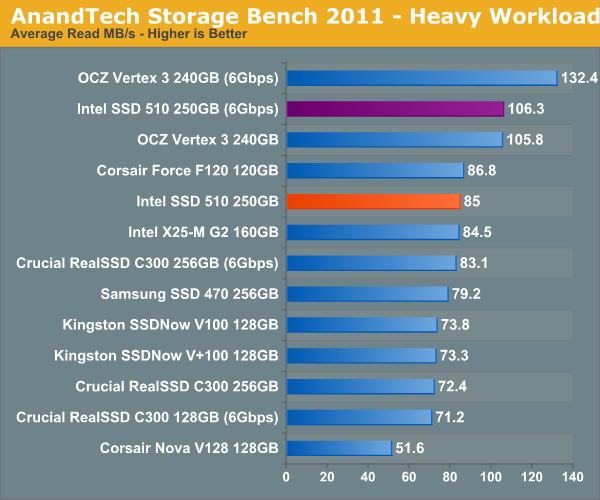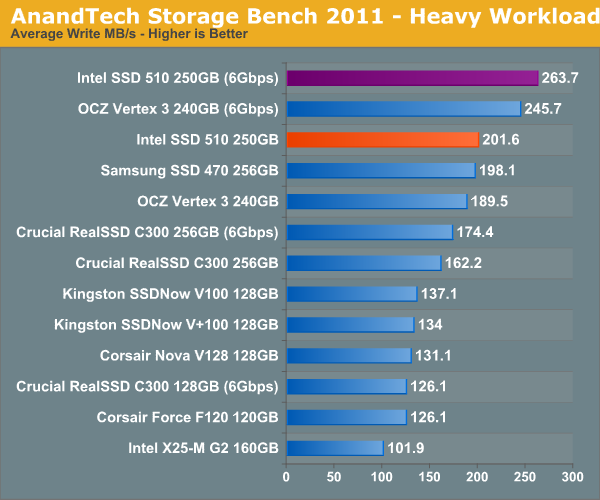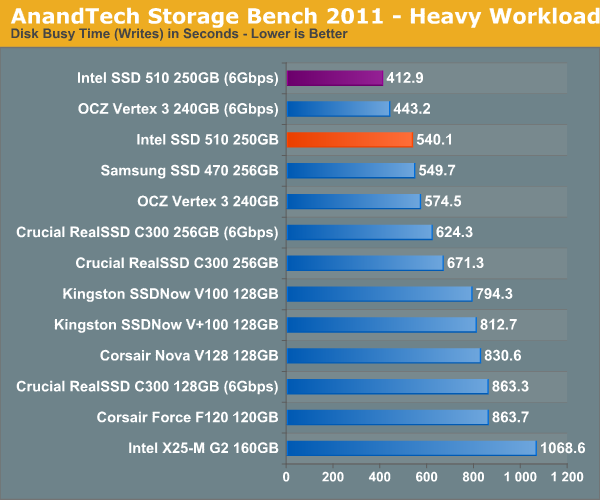The Intel SSD 510 Review
by Anand Lal Shimpi on March 2, 2011 1:23 AM EST- Posted in
- IT Computing
- Storage
- SSDs
- Intel
- Intel SSD 510
AnandTech Storage Bench 2011: Much Heavier
I didn't expect to have to debut this so soon, but I've been working on updated benchmarks for 2011. Last year we introduced our AnandTech Storage Bench, a suite of benchmarks that took traces of real OS/application usage and played them back in a repeatable manner. I assembled the traces myself out of frustration with the majority of what we have today in terms of SSD benchmarks.
Although the AnandTech Storage Bench tests did a good job of characterizing SSD performance, they weren't stressful enough. All of the tests performed less than 10GB of reads/writes and typically involved only 4GB of writes specifically. That's not even enough exceed the spare area on most SSDs. Most canned SSD benchmarks don't even come close to writing a single gigabyte of data, but that doesn't mean that simply writing 4GB is acceptable.
Originally I kept the benchmarks short enough that they wouldn't be a burden to run (~30 minutes) but long enough that they were representative of what a power user might do with their system.
Not too long ago I tweeted that I had created what I referred to as the Mother of All SSD Benchmarks (MOASB). Rather than only writing 4GB of data to the drive, this benchmark writes 106.32GB. It's the load you'd put on a drive after nearly two weeks of constant usage. And it takes a *long* time to run.
I'll be sharing the full details of the benchmark in some upcoming SSD articles but here are some details:
1) The MOASB, officially called AnandTech Storage Bench 2011 - Heavy Workload, mainly focuses on the times when your I/O activity is the highest. There is a lot of downloading and application installing that happens during the course of this test. My thinking was that it's during application installs, file copies, downloading and multitasking with all of this that you can really notice performance differences between drives.
2) I tried to cover as many bases as possible with the software I incorporated into this test. There's a lot of photo editing in Photoshop, HTML editing in Dreamweaver, web browsing, game playing/level loading (Starcraft II & WoW are both a part of the test) as well as general use stuff (application installing, virus scanning). I included a large amount of email downloading, document creation and editing as well. To top it all off I even use Visual Studio 2008 to build Chromium during the test.
Many of you have asked for a better way to really characterize performance. Simply looking at IOPS doesn't really say much. As a result I'm going to be presenting Storage Bench 2011 data in a slightly different way. We'll have performance represented as Average MB/s, with higher numbers being better. At the same time I'll be reporting how long the SSD was busy while running this test. These disk busy graphs will show you exactly how much time was shaved off by using a faster drive vs. a slower one during the course of this test. Finally, I will also break out performance into reads, writes and combined. The reason I do this is to help balance out the fact that this test is unusually write intensive, which can often hide the benefits of a drive with good read performance.
There's also a new light workload for 2011. This is a far more reasonable, typical every day use case benchmark. Lots of web browsing, photo editing (but with a greater focus on photo consumption), video playback as well as some application installs and gaming. This test isn't nearly as write intensive as the MOASB but it's still multiple times more write intensive than what we were running last year.
As always I don't believe that these two benchmarks alone are enough to characterize the performance of a drive, but hopefully along with the rest of our tests they will help provide a better idea.
The testbed for Storage Bench 2011 has changed as well. We're now using a Sandy Bridge platform with full 6Gbps support for these tests. All of the older tests are still run on our X58 platform.
AnandTech Storage Bench 2011 - Heavy Workload
We'll start out by looking at average data rate throughout our new heavy workload test:

There's simply no dethroning the Vertex 3, but Intel's SSD 510 does come dangerously close. Over a 6Gbps interface the 510 delivers 93% of the performance of the Vertex 3. Over a 3Gbps interface the gap narrows to a meager 5.2%.
The breakdown of reads vs. writes tells us more of what's going on:

The Vertex 3 is nearly 25% faster than the 510 if we just isolate the reads conducted by our benchmark. Remember the poor random read performance? I suspect that's at play here. The Intel SSD 510 on a 6Gbps interface is about the speed of the Vertex 3 on a 3Gbps port.

Ah ha! This is where the picture shifts. Our heavy workload does have a significant amount of incompressible writes which significantly reduce the performance of the Vertex 3. The V3 loses enough ground that the 510 is 7% faster in writes during our benchmark.
The next three charts just represent the same data, but in a different manner. Instead of looking at average data rate, we're looking at how long the disk was busy for during this entire test. Note that disk busy time excludes any and all idles, this is just how long the SSD was busy doing something:













128 Comments
View All Comments
TSnor - Wednesday, March 2, 2011 - link
Article says "Write speed with fully incompressible data is easily a victory for the SF-2200 based OCZ Vertex 3. "I think you meant "Write speed with compressible data is easily a victory for the SF-2200 based OCZ Vertex 3. "
Excellent article, I was interested in the 3rd gen intel SSD, but not at these specs. Wish you gave the read latency time (it can be inferred to some degree from the elapsed time charts which are good). Also, given the size of internal cache these devices use perhaps running for more than 3 mins would be a good idea. The average performance is still changing at 3 mins.
AstroGuardian - Wednesday, March 2, 2011 - link
"I mentioned earlier that the 510 would go through Intel’s extensive validation testing, just like any other Intel product."Yea right! Just like the H67 and P67. Yea, that made me so happy.
Anand Lal Shimpi - Wednesday, March 2, 2011 - link
That's 100% a valid point and it does show that even with extensive validation errors can still get through.You'll remember that the X25-M was the first to have major firmware issues before any of its present day competitors were even created.
Only time will tell how well Intel has learned from those experiences and how seriously it's taking the validation of the 510. Initial compatibility testing looks good but we've got a long road ahead of us.
Take care,
Anand
Ryomitomo - Thursday, March 3, 2011 - link
At least Intel's labs identified the problems themselves, disclosed the problem themselves, will recall and exchange to fix the problem.These things makes me feel very confident to buy future Intel products.
Nihility - Thursday, March 3, 2011 - link
A good point. Unlike certain NVIDIA mobile chipsets.Chloiber - Wednesday, March 2, 2011 - link
...I think Anand is right. Many of you are complaining, but as he said on the final page: it is not clear, where the actual limits are for random speeds. Of course, it's always better to have more. The thing is, that your PC at home can't benefit from 60'000 IOPS. It just can't. You can run it through benchmarks which show high numbers, but as soon as you feed the drive and the CPU with real data, the drive is NOT the limiting factor anymore.I'm not saying that it's a good thing the Intel 510 has such low random speeds, compared to other, even older drives. But in the end, the question is whether or not you can actually benefit from 200MB/s random reads and random writes with QDs above 4.
Anand said himself, and I assure you that he is correct - you can trace it yourself if you want - that with standard workload on home desktop PCs, Queue Depth rarely exceeds 1 or 2, especially not with an SSD in your system. Not even during boot!
And now THINK AGAIN. What are the random 4k read speeds for low QD of EVERY SSD today? It's actually limited by the NAND being used and it's between 20MB/s and 30MB/s for EVERY SSD.
Again, I'm not saying that high IOPS aren't important. I'm just saying, they aren't as important as you think. Not anymore, not in the very high regions we are today and especially not with very high QDs.
The 510 seems to have very good performance in real world benchmarks - it seems that most of you rate synthetic benchmarks higher than real world benchmarks. This, I don't quite understand.
semo - Wednesday, March 2, 2011 - link
The fact is, you will not be using a very competitively priced 250GB SSD for net browsing. When I get my SSD, I'll be using it to store my test VMs where I do a lot of software installations and snapshot jumping.The 510 is not a mainstream product where the QD rarely goes above 2. Not at that price at least. I've installed an SSD for a few average users but they were all 60GB drives. I could never justify the price of a 250GB SSD to them but a pro user might (i.e. someone who might make use of a high IOPS drive).
semo - Wednesday, March 2, 2011 - link
Meant to say "uncompetitively". Too expensive for the average computer user.tno - Thursday, March 3, 2011 - link
Spot on, and so a mainstream drive this is not. As workstation drive, however, this seems pretty solid.Nentor - Wednesday, March 2, 2011 - link
If it (the 510) was very cheap everything you say makes sense, but since it is not they'd better make it as fast as possible.